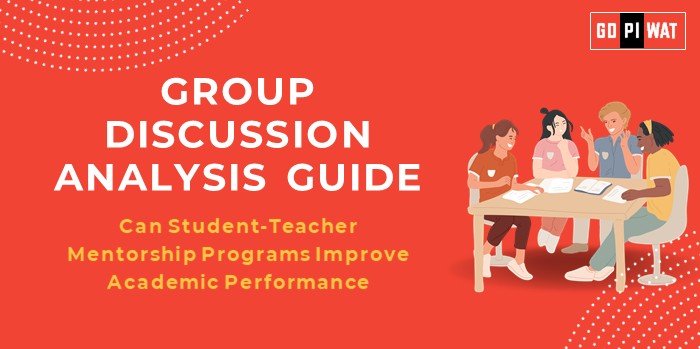📋 GD Analysis Guide: Can Student-Teacher Mentorship Programs Improve Academic Performance?
🌟 Introduction to the Topic
Context Setting: In today’s competitive academic landscape, mentorship programs between students and teachers are increasingly recognized as catalysts for academic success.
Topic Background: Mentorship programs bridge gaps between classroom teaching and personalized guidance, addressing diverse student needs. Originating in global educational practices, these programs have gained traction due to proven impacts on student engagement and performance.
📊 Quick Facts and Key Statistics
- 👩🏫 Students Participating in Mentorship Programs: Over 75% report improved academic confidence (Source: Educational Research Surveys, 2023).
- 📉 Dropout Rates: Reduced by 18% in schools with active mentorship programs.
- 📊 Customized Learning Plans: Lead to 25% better comprehension in STEM subjects.
- 💬 Teacher Satisfaction: Programs improve teacher-student rapport, enhancing classroom interaction.
👥 Stakeholders and Their Roles
- 🏫 Schools and Institutions: Provide frameworks and allocate resources for mentorship programs.
- 👨🏫 Teachers: Serve as mentors, offering guidance tailored to individual learning needs.
- 🎓 Students: Engage actively to leverage mentorship for academic and personal growth.
- 👨👩👧👦 Parents: Collaborate with mentors to ensure holistic development.
- 🏛️ Policy Makers: Create incentives and frameworks for mentorship adoption.
🏆 Achievements and Challenges
✨ Achievements:
- ✔️ Enhanced Academic Outcomes: Mentorship correlates with a 15% improvement in test scores.
- ✔️ Individualized Attention: Programs address diverse learning needs, fostering inclusivity.
- ✔️ Emotional Support: Reduced stress levels in students enhance overall well-being.
- ✔️ Skill Development: Students develop critical thinking and problem-solving skills.
⚠️ Challenges:
- 🚧 Resource Constraints: Limited funding affects program scalability.
- 🚧 Time Management: Teachers often struggle to balance mentorship and teaching responsibilities.
- 🚧 Measuring Impact: Difficulties in quantifying long-term mentorship benefits.
🌍 Global Comparisons:
- 🇫🇮 Finland: Comprehensive mentorship programs improve overall student engagement.
- 🇺🇸 USA: Structured programs like AVID (Advancement Via Individual Determination) show positive academic results.
💡 Structured Arguments for Discussion
✔️ Supporting Stance:
“Mentorship programs provide personalized guidance, significantly improving academic performance and emotional resilience.”
❌ Opposing Stance:
“Mentorship programs may overburden teachers and lack standardized metrics for success.”
⚖️ Balanced Perspective:
“While mentorship programs boost academic outcomes, their success depends on adequate resources and structured implementation.”
🧠 Effective Discussion Approaches
- 📊 Start with data: “Schools with mentorship programs report an 18% lower dropout rate…”
- 📖 Use a case study: “In Finland, student-teacher mentorship improved national educational rankings…”
- ⚖️ Contrast introduction: “While mentorship programs show promise, implementation remains a challenge.”
🛠️ Counter-Argument Handling:
- “Acknowledge teacher workload concerns but propose solutions like external mentors.”
- “Cite global examples to support claims about program effectiveness.”
🔍 Strategic Analysis (SWOT)
💪 Strengths:
- ✔️ Improved learning outcomes.
- ✔️ Better teacher-student rapport.
❌ Weaknesses:
- 🚧 Requires additional resources.
- 🚧 Lack of universal framework.
🌟 Opportunities:
- 📈 Expansion to underserved areas.
- 📈 Integration with technology.
⚡ Threats:
- ❓ Resource constraints.
- ❓ Resistance to change in traditional systems.
📈 Connecting with B-School Applications
Real-World Applications: Projects on program scalability, resource allocation, or impact assessment.
Sample Questions:
- 💬 “How would you design a mentorship program for diverse learners?”
- 💬 “What metrics would you use to evaluate mentorship success?”
Insights for Students: Explore mentorship program design for social impact or education-focused internships.


